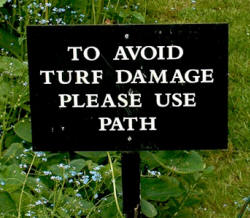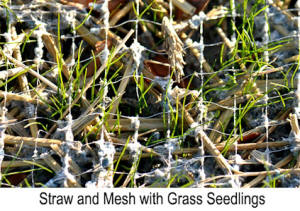Now that, with luck, all the
construction is completed, it is time to address any issues
you have with your lawn. Of course you can always live with
the lawn in its current condition, but if it has been
damaged during construction or is old and fatigued, you
might want to whip into shape to complement your new beds
and borders.
You will generally have three options for the lawn:
A. Rejuvenate the Existing Lawn - Now would be a good time to
"rejuvenate" the lawn since the
hardscape and major
excavations are completed so there will be no more heavy
machinery or extra foot traffic to compact the soils.
 Rejuvenation of a lawn basically involves efforts to
invigorate and improve the quality of the existing turfgrass.
In this process, you may want to fill in any ruts or damaged
areas with new topsoil to make it level with the surrounding
soil. To help alleviate the soil compaction, you can use a
core aeration machine to punch holes 1.5 to 2 inches deep
every 3 or 4 inches in all direction. This will help
introduce air and water into the hard soil.
Rejuvenation of a lawn basically involves efforts to
invigorate and improve the quality of the existing turfgrass.
In this process, you may want to fill in any ruts or damaged
areas with new topsoil to make it level with the surrounding
soil. To help alleviate the soil compaction, you can use a
core aeration machine to punch holes 1.5 to 2 inches deep
every 3 or 4 inches in all direction. This will help
introduce air and water into the hard soil.
After spreading the new topsoil and/or completing the core
aeration, you should spread new grass seed and then rake the
soil to make sure there is good seed to soil contact. If it
is a small job, tamp the soil down with the end of a stiff
rake or use a lawn roller (minus any water) to gently firm
the soil. Topdress the area with a standard application of
lawn fertilizer and then keep the soil moist and well
irrigated.
Do NOT use products that
contain a pre-emergence crabgrass herbicide since this
will kill the desirable grass seedlings too.
B. Replace the Lawn by Reseeding - A more drastic but thorough approach
is to remove all existing grass by killing it with an
herbicide such as
glyphosate i.e. RoundUp or other similar
post-emergent products. Once the grass is dead, till the
entire area and make sure that the surface slope is proper,
the soil surface is smooth and the drainage patterns are in
the correct direction.

From the results of a
soil test, apply the recommended
nutrients and pH adjustments. Then spread the grass seed,
firm it into the soil and put down a thin layer of straw.
Follow this by watering with the intent of keeping the soil
moist but not water logged. The amount you apply will vary
by the air temperature and soil type. In many areas,
reseeding is best done after Labor Day in the fall. The
second best time is in the early spring before the heat of
the summer.
Be sure to use the highest quality
grass seed available. There is absolutely no sense in
skimping on a few dollars at this point in the process.
Also, check with your local Land Grant University’s
Extension Service to be sure that you get species of grass
adapted to your particular area. There are a lot of grass
advertisements with amazing claims that can often lead you
down a very bad path.
C. Replace the Lawn with Sod - The most common mistake people make
with sod is that they think they can just lay it down and it
will magically grow. In reality, you should prepare the soil
and the site exactly the same as if you were going to plant
seed (See Section B. above). Sure, you can lay sod on
cement, keep it watered constantly and it will survive for a
time. But, if you want its roots to penetrate into the soil
for better long-term turf health, you need to have a loose,
nicely prepared soil.
Sod is grown at a highly irrigated and fertilized turf farm
which often has an organic soil. It is also generally an
individual species of grass such as
Kentucky bluegrass
rather than a mixture of grass species which is usually
recommended for general purpose i.e. non-irrigated, home
lawns. Check with your sod source to be sure you are getting
a grass that is suitable for your particular site. This is
especially true if you have a lot of shade. You don't want a
full sun type of grass which will not grow well under those
conditions.
The positives of sod are, of course, instant grass but it
can also be the fact that it can be laid down almost any
time of the year as long as it is watered adequately. The
downside is that it will cost a lot more than seeded lawns.



